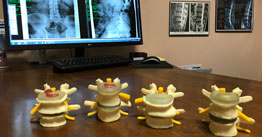Spinal Decompression
DRX9000 Spinal Decompression
The best non-surgical solution for bulging and herniated discs
Many patients that would have had to endure surgery for their pain have opted for Non-Surgical Spinal Decompression at City Spine Center in San Francisco with a great success rate.
You don't have to live with pain anymore. DRX-9000 Spinal Decompression was developed to effectively treat neck and lower back pain and sciatica resulting from herniated or deteriorated discs. Spinal Decompression treatment will not only significantly reduce back pain in many patients but also enables the majority of patients to return to more active lifestyles.
DRX-9000 Spinal Decompression has been proven effective in relieving the pain associated with bulging and herniated discs, degenerative disc disease, sciatica, and even relapse or failed back surgery. Since its release, clinical studies have revealed an amazing success rate of 86%-92% in treating lumbar disc-related problems with decompression. DRX-9000 is the most researched spinal decompression available. Please check out the research here:
https://www.excitemedical.com/drx9000-research/
DRX-9000 Spinal Decompression is FDA cleared and uses state-of-the-art technology to apply a specific distraction force to relieve nerve compression associated with low back pain and sciatica. It is true spinal decompression treatment, not traction, specifically treating affected spinal levels.
At City Spine Center we are committed to delivering life changing results through the most advanced, scientifically backed DRX-9000 Spinal Decompression treatment.
Contact our office today at (415) 668-2888 to schedule an initial consultation with Dr. Chau to determine if you are a candidate for treatment. After carefully studying your case history and exam findings, he will sit down and explain his plan of action for you. After answering any questions you may have about the recommended plan, you may begin your treatment.









